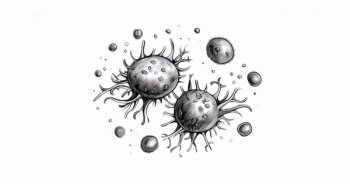
Axatilimab Plus Ruxolitinib/Belumosudil May Yield Benefit in cGVHD
In a retrospective cohort of patients with severe chronic GVHD, combination axatilimab with other GVHD therapies led to clinical benefit.
The combination of axatilimab-csfr (Niktimvo) with ruxolitinib (Jakafi) and/or belumosudil (Rezurock) yielded favorable responses in patients with severe chronic graft-vs-host disease (cGVHD), according to a retrospective study presented at the 2025 Tandem Meeting.
In the single-center, retrospective study of 8 heavily pretreated patients, the treatment led to an overall response rate (ORR) of 25% by National Institutes of Health (NIH) Consensus Criteria and 75% by Clinically Significant Symptomatic Improvement (CSSI) criteria, demonstrating the clinical benefit of combination therapy in heavily pretreated patients with cGVHD.
“This is the first report of axatilimab used in combination with ruxolitinib and/or belumosudil, and demonstrates that combination with CSF-1R, JAK2, and ROCK2 inhibition is feasible, tolerable, and may yield clinical benefit in highly refractory cases of cGVHD,” said Jean Caputo, APRN-CNP, of the division of hematology at The Ohio State University, in Columbus, Ohio, in her presentation of the data.
Axatilimab, a CSF-1R–blocking antibody, is the most recently approved treatment for cGVHD, for use after at least 2 prior lines of systemic therapy.2The phase 3 AGAVE-201 trial (NCT04710576), which led to the approval, did not allow combination with other cGVHD therapies such as ruxolitinib and belumosudil.3
Patients in this study were treated prior to axatilimab’s approval from January 1, 2022, to July 4, 2024.1 They received the dose of 0.3 mg/kg every 2 weeks, which was the FDA-approved dose. The primary end point of the study was ORR at 24 weeks, measured by NIH Consensus Criteria and CSSI as deemed by provider. Safety measures such as frequency and severity of treatment-related adverse events (AEs) were also reported.
“This is measured by NIH Consensus Criteria, which is the objective grading scale for cGVHD, which classifies disease as mild, moderate, or severe based on number of organs involved and severity of symptoms,” Caputo explained in her presentation. “We also measured based on CSSI, and this is a subjective grading scale that is deemed by provider assessment and also includes patient report of symptoms. This becomes an…important part of GVHD assessment in patients with severe and refractory treatment, as even subject to improvements in symptoms, can mean meaningful impact on quality of life.”
Four of the patients were men and 4 were women. Six had received myeloablative conditioning and 2 had reduced intensity conditioning. All had received an allogeneic hematopoietic cell graft from peripheral blood; 5 from a matched unrelated donor and 3 from related donors. They developed GVHD at a median of 5.1 months (range, 4.0-9.1) and went a median of 21.1 months between diagnosis and initiation of axatilimab. The grade of their cGVHD at diagnosis was mild in 4, moderate in 3, and severe in only 1, but at the time of axatilimab initiation, all had severe GVHD and 5 had sclerodermous skin involvement, including 2 with body surface area of greater than 50%. One patient had bronchiolitis obliterans.
They had received a median of 5 prior lines of therapy (range, 4 to 9); all had received prior ruxolitinib and belumosudil, and 4 of them had received them in combination. When they received axatilimab, it was combined with both ruxolitinib and belumosudil in 4 patients, with only belumosudil in 3 patients, and with ruxolitinib in 1 patients.
Of the 6 partial responders by CSSI, 4 received axatilimab, ruxolitinib, and belumosudil, 1 received axatilimab and ruxolitinib, and 1 received axatilimab and belumosudil. There were no complete responses reported with the combinations. A best response of stable disease was reported in 5 patients (62.5%) by NIH and 1 (12.5%) by CSSI criteria and a best response of progressive disease was reported in 1 patient (12.5%) by both NIH and CSSI criteria.
The median time to response was 71 days and the duration of response was 295 days by NIH criteria, and 103 days and 219 days, respectively, by CSSI criteria. Caputo said that 3 patients who had initial response by CSSI later experienced disease progression and discontinued axatilimab.
Looking at organ-specific responses, in 7 with skin GVHD, the ORR was 15% by NIH and 43% by CSSI. In 4 patients with oral involvement, the ORR was 25% by NIH and 75% by CSSI. In 2 patients with lung involvement by CSSI, there was an ORR of 50%, and in 5 with musculoskeletal involvement by CSSI, there was an ORR of 20%.
“Partial responses here included improvement in sclerosis, improvement in ulcerations in both the skin and the mouth, improved range of motion in infected joints, and [reduced] dyspnea on exertion that were measurable but not enough to impact their NIH grade,” said Caputo.
Looking at serum cytokines to gauge the degree of inflammation and immune dysregulation caused by GVHD, the 6 CSSI responders had decreased or normalized levels of interleukin-6, interleukin-2R, and interleukin-10, whereas 1 additional patient with disease progression had elevated levels of these cytokines when evaluated.
There were no patients who discontinued axatilimab because of intolerance and no fatal AEs reported. There were 5 incidences of anemia, 3 of grade 1 and 1 each of grades 2 and 3. There were 2 grade 2 and 1 grade 3 viral upper respiratory tract infections. Three serious AEs of grade 3 or higher were reported in the same patient, which were septic arthritis, osteomyelitis, and elevated gamma-glutamyl transferase (GGT). Treatment-emergent AEs led to dose discontinuation in the patient with elevated GGT and dose reduction in a patient with grade 2 fatigue.
Although the ORR was lower than the 74% found in AGAVE-201,3 “patients analyzed here had more severe disease, and 50% of our patients had already been refractory to combination ruxolitinib and belumosudil among responding patients,” Caputo noted.1
References
1. Caputo J, Perrireddi A, Wall SA, et al. Axatilimab combination therapies with ruxolitinib and/or belumosudil induces clinical responses in patients with severe, treatment-refractory chronic GVHD. Presented at: 2025 Transplantation and Cellular Therapy Meetings; February 12-15, 2025; Honolulu, HI. Abstract ID 106.
2. FDA approves axatilimab-csfr for chronic graft-versus-host disease. FDA. August 14, 2024. Accessed February 14, 2025.
3. Wolff D, Cutler C, Lee SJ, et al. Axatilimab in recurrent or refractory chronic graft-versus-host disease. N Engl J Med. 2024;391(11):1002-1014. doi:10.1056/NEJMoa2401537








































